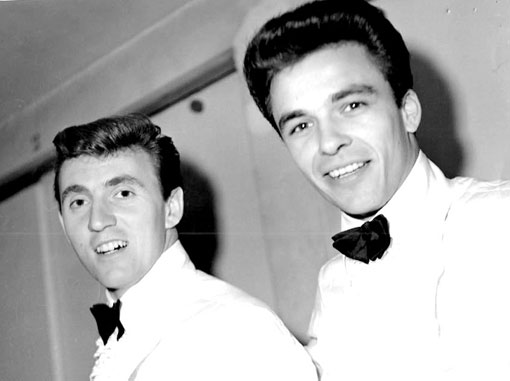< Thread 109 Thread 110 (28 replies so far) Thread 111 >
Replies 21-28
< replies 1-20
.jpg)
DATE: 23 March 2017
CONNECTION WITH QE: pupil 1957-64
Putting foreign bodies in a piano [reply 19], touching the strings, produces what is called a 'prepared piano'. It has featured as an instrument in pieces by John Cage and others. Sticking drawing pins into the hammers produces a 'tack piano'. Glenn Gould experimented with a purpose-built one (which he called a 'harpsipiano', using it in a 1962 television broadcast in which he played Contrapunctus IV from Bach's Art of Fugue. I found this in Wiki; the article gives a memorable warning about what happens if you expect to recover a decent piano when you take out the drawing pins: the sound is reduced "to dark mush once the tacks are removed". I don't suppose poor Mr Biggs had any of these thoughts in his mind when he decluttered the QE piano ...
 Then & Now
Then & NowDATE: 23 March 2017
CONNECTION WITH QE: pupil 1954-59
According to my parents and grandmother, sticking drawing-pins in the hammers was also the method widely used in the East End of London, at least from the 1890s to 1930s, to produce that 'honky-tonk' sound charactereistic of traditional Cockney piano-playing. Every pub had a piano thus modified and probably most of the pianos that were regularly taken out of houses into the streets for 'knees-ups' had also had the treatment. It seems that most people in Silvertown, however poor, owned a cheap (wooden-framed) upright. The outwardly beautiful Victorian upright that moved around with my grandparents from Plumstead to Silvertown and thence to Barnet somehow escaped the drawing-pin treatment. I used to drive my grandmother and my mother (who was a cinema pianist for silent films in the '20s) crazy trying to play the blues on it. It was so out of tune in places that you had to remember to hit the next key up from the one it should have been, in order to get somewhere near the note you wanted. If a string was only a quarter-tone flat, it was a toss-up between that key and the adjacent one! Unfortunately my mother let a rag-and-bone man have it (for nothing, of course) in 1975, when she moved. She also threw out some tapes of me playing it which, though excruciating, would have been of great interest to me now. I'm still at it, trying to play the blues (and other things these days) on a piano, but it's a 1930s baby grand inherited from Angela's mother and it actually gets tuned now and again!

.jpg) Then & Now
Then & NowDATE: 25 March 2017
CONNECTION WITH QE: pupil 56-63
Thanks for putting more info on about Willy Biggs (Bigsy), Michael [reply 19]. I have enjoyed also looking over the earlier replies from 2012 and 2013 and on other threads about Bigsy and his successor, David (Pansy) Patrick. They were both after my time in regards to attending a music class but I have enjoyed reading about them. Dickie Whittington was my music teacher for the years after 1956 and there is much on the site about him too. Thanks for the info about the sound effects of doctoring pianos, Nigel and Vic [replies 21 & 22]. I did not know so much can be done with pianos in regard to altering the sounds produced. When I learnt to play the piano, going for lessons at the dear neighbor lady's house at 1 Oakwood Avenue in my latter days at school in the 1960's, I just used to make use of the sound pedals at the bottom of the piano for softness and loudness effects. I still have the music books I used in order to play those simple tunes with the lady's pencil recording of dates under the pieces as to where I had got to each week. Some later ones I used I have passed on to my granddaughter Wendy, as she makes her own progress in playing the piano.I hope others too get pleasure from reading over earlier postings on the site along with the current replies.
DATE: 25 March 2017
CONNECTION WITH QE: pupil 1957-64
[Re reply 20]: Did anybody else go to see Chuck Berry at the Finsbury Park Astoria in May 1964? His first appearance in England, I think. Carl Perkins was also on the bill.

DATE: 26 March 2017
CONNECTION WITH QE: inmate 1957-64<
Hello Hedley after all these years! Yes I was at the Finsbury Park Astoria to see Chuck Berry, backed by the Nashville Teens. The Animals were also on the tour and I had seen them possibly a day or two before at the Manor House pub, probably with Eric Disdale and other usual suspects from Borehamwood. Two things I remember about that gig - firstly the enormous Gibson amp used by Chuck Berry, and secondly that his guitar was out of tune

.jpg) Then & Now
Then & NowDATE: 01 April 2017
CONNECTION WITH QE: pupil 56-63
Others on the internet have commented about Chuck Berry's guitar being out of tune on occasions but he seems genuinely to have been forgiven due to his part in the development of rock and roll. There are many tributes to him from rock and roll worthies still alive. I did not play guitars or any other rock band associated instruments myself but still enjoy rocking and rolling with my wife on occasions. With people like Mick Jagger and the other Rolling Stones still about and performing, we are certainly not the oldest rockers in town though.

DATE: 04 April 2017
CONNECTION WITH QE: inmate 1957-64
James, I think you will find that his guitar was out of tune most of the time, I have downloaded many live recordings of his shows and this problem persisted!!
28th  REPLY
REPLY
 Then & Now
Then & NowDATE: 04 March 2017
CONNECTION WITH QE: Inmate 1956-1963
Tuning guitars back in the 60's was always a bit of a pig. With no electronic tuners on hand to help it was a case of tuning up to a piano - assuming that there was a piano available and it was in tune - or to a tuning fork or pitch pipes. Then once you had tuned up your own guitar you had to make sure that all the other guitars in the band were tuned up to the same source or to you! Maybe Chuck Berry was in tune and all the other guitarists weren't! One rock 'n' roll musician who had an abiding problem tuning his instrument was Bruce Welch, the rhythm guitarist of the Shadows. He got so fed up arriving hours early at gigs to ensure tuning perfection that he eventually paid bass player John Rostill £10 a week to do the job for him! That's Bruce Welch & John Rostill in the photo above (supplied by Martyn).